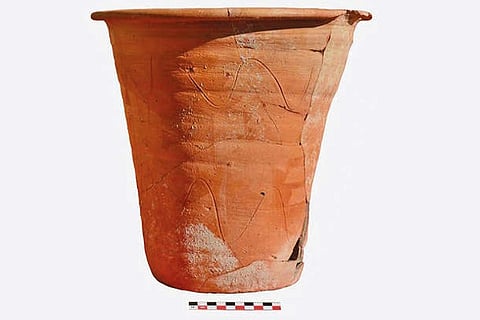

New York
Archaeologists working at ancient Roman sites commonly find ceramics, but it is not always easy to know what these objects were used for. Wine storage? Food transportation? Tableware? Or were they purely decorative? Experts often disagree. But now a team of researchers working at a Roman site that dates from about 450 to 500 A.D. have definitive proof that one of the pots they found was a portable toilet.
The terra-cotta pot, described in the Journal of Archaeological Science: Reports, was found in the ruins of a villa near the Italian town of Gerace in Sicily. The pot is round with sloping sides, standing a foot high and 13 inches wide at the rim. The authors suggest that it could have been used by sitting on it, but more likely it was placed beneath a timber or wicker chair equipped with a cover over a suitable hole.
Chamber pots have been found at various ancient archaeological digs. One was found recently at a 2,700-year-old site in Jerusalem; another, dating from 1,300 B.C., was excavated at the Egyptian city of Tell el-Amarna. Chamber pots from as early as the sixth century B.C. have also been found in Greece. Although some documents suggest that Roman chamber pots could have been made of onyx or gold, only terra-cotta and bronze pots have been found. Most have been identified only by their shape or their location in a house, but there are now various techniques for establishing their function more conclusively. These researchers did it by looking for human intestinal parasites.
When they initially found the pot, it was in pieces, so they had to first put the fragments back together. The pot is burnt orange, with two wavy lines incised on the outside as decoration. Inside, at the bottom and sides of the pot, they found a crust — calcified concretions that they hoped would help identify what the pot contained. They scraped a bit off for analysis. After preparing the sample in an acid bath to separate any organic material from the concretions, they were able to identify the preserved eggs of an intestinal parasite, the whipworm, which is excreted in human faeces. How the jar had been used was clear. Whipworms infect an estimated 800 million people worldwide, usually in tropical regions where access to proper sanitation is limited, but infections also occur in the southern United States. The worm lives in the colon and its eggs are excreted in faeces. They begin development outside the body and are transmitted by oral contact with contaminated hands, soil or food. Sometimes the disease, trichuriasis, produces no symptoms at all or just mild diarrhoea, but severe cases in children can lead to stunted growth and cognitive problems. The disease can be effectively treated with medication. Whipworms can be found in dogs, wolves, pigs and other animals, but the species found in the Roman artifact — Trichuris trichiura — is found only in humans, and is not transmissible to any other animal.
“The thing that stood out in the paper is their method could be developed so that we could have a general method for everyone,” said Karl J. Reinhard, a professor of environmental archaeology at the University of Nebraska who was not involved in the study. “It’s simple and something anyone can do anywhere. It could be applied to museum specimens as well. I would encourage the authors to continue this work and develop a method from which we all could benefit.”
Bakalar is a reporter with NYT©2022
The New York Times
Visit news.dtnext.in to explore our interactive epaper!
Download the DT Next app for more exciting features!
Click here for iOS
Click here for Android